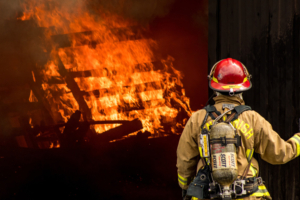How Do I Use A Fire Extinguisher? All You Need To Know
.In this article we are going to discuss the ins and outs of a fire extinguisher, how to use one and when to use one. We need to know the types of extinguishers, the types of fires, and the phases that fires go through.
Anatomy of the Fire Extinguisher
- Trigger – releases the solvent
- Safety pin – prevents accidental extinguishing
- Handle
- Pressure Gauge – green equals fully charged, red means not
- Hose/Nozzle – directs the stream (use a sweeping motion)
PRO-TIP:
Regularly inspect your extinguisher(s)!
Check for clean, readable labels and instructions, no rust & full pressure on the gauge. Log your inspections!
Fire Extinguishing Safety Rules
But First!
- If you are at work, pull the fire alarm and notify the fire department (or assign someone to this task).
- If you are at home, notify the fire department.
- Assist anyone in danger, or cannot evacuate on their own. Remember not to put yourself at risk.
IF IT’S SAFE:
- Notify someone that you are about to attempt extinguishing.
- Identify your evacuation path
- Never allow the flame to come between you and your way out!
- Here’s the Acronym of most importance: PASS
- Pull (the pin)
- Aim (the nozzle)
- Squeeze (the trigger)
- Sweep (sweeping motion)
Fight (the fire) or Flee (to safety)?
Questions to Consider Ourselves:
- Is the fire small enough for my efforts to even be effective?
- Do I remember how to use the extinguisher?
- Do I have the appropriate extinguisher available for this type of fire?
- Is the air safe to breath?
- Do I have an evacuation route in place?
Types of Fire: A, B, C, D, K
Here are 5 types of fire and examples:
Class A: wood, paper, cloth, rubber, & many plastics
Class B: flammable liquids
- Gas, propane, butane, petroleum greases, tars, oils, oil based paints, solvents, alcohol
- NOT cooking oil or cooking fats
Type Class C: energized electrical equipment
- Computers, appliances, motors, transformers
- ONLY if there’s power to the item. No electrical supply and these items fall under a different category
Class D: combustible metals
- Magnesium, calcium, sodium, lithium, potassium, phosphorus
Class K: vegetable oils, animal oils, cooking grease and fats
Types of Extinguishers
There are many types of extinguishers on the market. Be sure that whichever one you pick is appropriate for your work or home space. Here are a few that are available. Learn from my mistakes and know that extinguishers are not all “universal”!
- Water & Foam: Class A fires only
- Carbon Dioxide: Class B&C, ineffective on A
- Multi-purpose Dry Chemical: Class A, B, C
- Ordinary Dry Chemical: Class B&C
- Dry Powder Chemical: Class D only
- Clean Agent: Class A, B, C
- Wet Chemical: Class K
Most commonly in your home you are likely to have a Multi-purpose or a Clean Agent style extinguisher that covers classes A, B, and C.
If you are a kitchen connoisseur, having a Class K in your kitchen might be a beneficial preparation to have!
Stages of a Fire:
Incipient: Phase 1
- Flame still in beginning stage
- Small flame, not wide spread at this time
- Smoke allows for visibility & almost normal breathing in the space
- Heat emitted is low
Growth: Phase 2
- Sufficient oxygen and fuel available
- Thicker layer of smoke forming
- No condensation on windows
- Windows may show brown staining or start to crack
Fully Developed: Phase 3
- Dark/black smoke
- Dense/thick smoke
- Substantial heat
- Blackened windows
- Visible exterior flame
Decay: Phase 4
- Fuel and oxygen is running out

Fire Size: Extinguish or Evacuate?
Evacuate If:
- Fire is a flammable solvent (such as fuel)
- 5.6 square meters or larger
- Partially hidden in a wall or ceiling – size is undetermined
- Cannot be reached from standing – meaning above your head or taller than your head
- Heat is too intense
- You need to crawl or be on the floor because the heat is too thick
Extinguish If:
- #1 & most importantly: you feel comfortable trying. The first rule is that if you do not feel safe and secure, evacuate and let the professionals take care of the situation.
- Limited to the original material that was ignited
- Ex: A box of Kleenex lit up, and has not spread, then you may attempt extinguishing
- It is contained
- Flame is not higher than your head
- Good visibility
- Protective gear not required for your safety
- Room temperature not raised
Prevention
- Test smoke detectors (monthly or on a calendared schedule)
- No smoking indoors. Never leave buds on ground outdoors. Always properly dispose of these!
- Candles – never leave unattended
- Store flammable products properly
- Know where all shut offs are, such as gas lines, circuit breakers, appliances and fuses
- Maintain your electrical cords – check for frayed or damaged cords. Check for power bars and over-burdened electric plug ins
- Inspect heating sources (furnace filters, hot water heater, regular maintenance)
Conclusion:
And just like that, you are ready to extinguish in the hopefully unlikely event of a mis-placed fire! Congratulations on educating yourself and being one step closer in your preparedness. Locate your extinguisher, follow the maintenance guidelines, and feel ready to embrace whatever life may throw your way. Have a great day!



